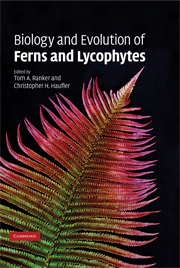Book contents
- Frontmatter
- Contents
- List of contributors
- Preface
- Acknowledgments
- Part I Development and morphogenesis
- Part II Genetics and reproduction
- 4 Population genetics
- 5 Antheridiogens
- 6 Structure and evolution of fern plastid genomes
- 7 Evolution of the nuclear genome of ferns and lycophytes
- Part III Ecology
- Part IV Systematics and evolutionary biology
- Index
- References
7 - Evolution of the nuclear genome of ferns and lycophytes
Published online by Cambridge University Press: 11 August 2009
- Frontmatter
- Contents
- List of contributors
- Preface
- Acknowledgments
- Part I Development and morphogenesis
- Part II Genetics and reproduction
- 4 Population genetics
- 5 Antheridiogens
- 6 Structure and evolution of fern plastid genomes
- 7 Evolution of the nuclear genome of ferns and lycophytes
- Part III Ecology
- Part IV Systematics and evolutionary biology
- Index
- References
Summary
Introduction
Analyses of gene expression and function, genetic networks, population polymorphisms, and genome organization at the whole genome level have enabled research on previously intractable questions (reviewed in Wolfe and Li, 2003). Among plant lineages, genomic approaches have been most widely applied in the angiosperms, where significant resources have been developed. Angiosperm studies utilizing genome scale analyses have made several important advances, including the identification of an extensive history of genome duplications (Blanc et al., 2003; Schlueter et al., 2004; Cui et al., 2006), progress in understanding flower development and evolution (Doust et al., 2005; Whibley et al., 2006), characterization of the genetics underlying speciation and adaptation (Bradshaw and Schemske, 2003; Rieseberg et al., 2003; Lai et al., 2005; Eyre-Walker, 2006), the identification and mapping of recombination hot spots (Drouaud et al., 2006), and the discovery and role of microRNAs (Bartel and Bartel, 2003; Bartel, 2004). Genomic analyses will undoubtedly continue to provide tests of longstanding questions and offer novel perspectives in biology. For example, modern genomic analyses are capable of explaining the origin of the exceptionally high chromosome numbers of homosporous ferns and lycophytes, a result that will shed light on eukaryotic genome organization and evolution.
Although there are rich biological and taxonomic resources for ferns and lycophytes, the genomics of these seed-free plants is still in its infancy, and the tools necessary for genomic studies lag behind those available for seed plants. The first homosporous fern linkage map was published only recently (Nakazato et al., 2006), whereas a large number of linkage maps for seed plants have accumulated since the 1980s
- Type
- Chapter
- Information
- Biology and Evolution of Ferns and Lycophytes , pp. 175 - 198Publisher: Cambridge University PressPrint publication year: 2008
References
- 27
- Cited by



